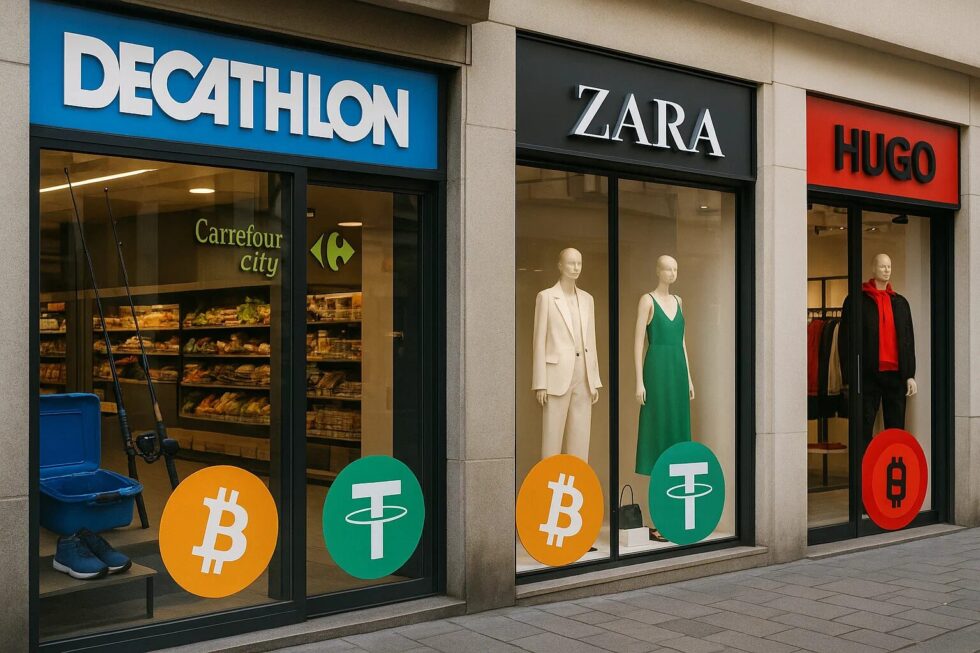Which European Online Stores Accept Bitcoin and USDT for Shopping

Crypto in e-commerce is no longer a futuristic concept but a present-day reality. More and more online and offline stores in Europe are starting to accept digital currencies such as Bitcoin and USDT (Tether) as valid payment methods. This trend is fueled by the growing popularity of cryptocurrencies, lower transaction fees compared to traditional banking, and the demand from younger, tech-savvy consumers who prefer borderless digital payments. As Europe becomes one of the leading hubs for crypto adoption, merchants are experimenting with different strategies to attract customers. Some accept crypto directly, while others work through payment processors. The development is particularly visible in retail, travel, electronics, and even luxury goods. Such transformations show how digital finance reshapes shopping habits in Germany, France, Spain, and beyond, as noted by G.business.
The rise of crypto in European e-commerce
Over the past five years, cryptocurrencies have moved from speculative assets to real payment tools. European regulators have gradually developed frameworks that make it easier for companies to integrate crypto payments into their checkout systems. According to industry data, more than 2,000 merchants across the EU now officially accept Bitcoin, and at least 700 accept stablecoins such as USDT. Germany and Switzerland are leading markets, thanks to strong fintech ecosystems and consumer trust in blockchain technology. For shoppers, this creates an opportunity to buy anything from airline tickets to electronics without converting digital assets into euros first. At the same time, retailers benefit from lower processing fees and faster settlements compared to credit cards.
Examples of industries where crypto is accepted:
- Electronics and gadgets stores
- Fashion and luxury goods retailers
- Travel agencies and airlines
- Food delivery platforms
- Hotels and hospitality services
- Online education platforms
- Gaming and digital services
Which online stores in Europe accept Bitcoin and USDT
Across Europe, several well-known companies have adopted crypto payments. For example, MediaMarkt in Germany allows Bitcoin transactions through external providers, while luxury fashion retailer Farfetch accepts Bitcoin across multiple European markets. Online travel agency Destinia lets travelers book hotels and flights with Bitcoin. In Switzerland, Digitec Galaxus, one of the largest e-commerce platforms, accepts over ten different cryptocurrencies including Bitcoin and USDT. Smaller niche shops, particularly in the organic food and eco-lifestyle sectors, are also experimenting with digital assets as a way to attract younger buyers. These developments show how crypto is becoming integrated into both mainstream and alternative retail sectors.
Some European shops that accept crypto payments:
- MediaMarkt (Germany, Austria): Bitcoin via payment providers
- Farfetch (Europe-wide): Bitcoin for luxury fashion
- Digitec Galaxus (Switzerland): Bitcoin, Ethereum, USDT, and more
- Destinia (Spain): Bitcoin for travel bookings
- Bitrefill (EU-wide): Gift cards for popular retailers using crypto
- CheapAir (Europe flights): Bitcoin and stablecoins
- Luxury Watches stores in Germany and Switzerland: Bitcoin and USDT
Benefits of using Bitcoin and USDT for shopping
Customers often choose Bitcoin for its reputation as the first and most recognized cryptocurrency, while USDT provides stability because it is pegged to the US dollar. This dual choice gives shoppers flexibility: Bitcoin is seen as innovative and prestigious, while USDT eliminates volatility risks. Merchants benefit by reaching an international audience, avoiding currency conversion fees, and receiving instant payments without chargebacks. Many businesses also highlight crypto acceptance in their marketing, positioning themselves as forward-thinking and customer-oriented. With the rise of blockchain-based loyalty programs, future benefits may also include discounts or exclusive rewards for paying with digital currencies.
Main advantages of paying with crypto:
- Faster transactions than bank transfers
- Lower fees than credit card payments
- Borderless use across countries
- Extra privacy for buyers
- Attractiveness for tech-savvy consumers
- No chargebacks for merchants
- Potential loyalty bonuses
Challenges and risks of crypto payments
While crypto adoption grows, several challenges remain. Price volatility of Bitcoin can discourage both consumers and merchants, even though USDT reduces this risk. Regulatory frameworks differ across EU countries, making integration complex. Payment processors such as BitPay or Coinbase Commerce often charge service fees, and not every consumer is familiar with crypto wallets. There are also concerns about transaction speed during network congestion, as well as environmental discussions around Bitcoin mining. Still, Europe’s push toward MiCA regulation (Markets in Crypto-Assets) is expected to bring clarity and encourage more businesses to join.
Key challenges for crypto in e-commerce:
- Volatility of Bitcoin value
- Differences in regulation across countries
- Technical knowledge required from consumers
- Processing fees from providers
- Limited adoption compared to cards and PayPal
- Energy consumption debates
- Taxation rules for individuals and companies
Countries leading the way in crypto adoption
Not all European countries adopt crypto at the same pace. Switzerland is considered a pioneer, with entire towns such as Zug branded as “Crypto Valley.” Germany officially recognizes cryptocurrencies as financial instruments, which has boosted trust among retailers. Spain and Portugal also lead in consumer adoption, especially for travel-related purchases. The UK, despite regulatory uncertainty after Brexit, still has significant adoption thanks to its strong fintech sector. In Eastern Europe, countries like Estonia and Lithuania are also innovators, often testing blockchain solutions at a national level.
Top European countries for crypto-friendly shopping:
| Country | Key Retailers Accepting Crypto | Special Notes |
|---|---|---|
| Germany | MediaMarkt, Saturn, online luxury | Strong fintech ecosystem |
| Switzerland | Digitec Galaxus, local shops | Crypto Valley (Zug) |
| Spain | Destinia, travel agencies | Strong tourism integration |
| Portugal | Hotels, restaurants, online services | Tax benefits for crypto users |
| UK | Fashion, gaming, fintech apps | Regulatory debates continue |
Future outlook for crypto in European retail
Experts believe the next phase will see more stablecoin integration, especially USDT and USDC, as these reduce volatility risks. Major retailers may gradually follow the example of early adopters like Digitec Galaxus. Travel, gaming, and luxury sectors will likely remain leaders, while supermarkets and food delivery platforms may expand crypto acceptance in the coming years. Partnerships with fintech firms will also play a role, ensuring secure and compliant payment systems. As blockchain technology matures, loyalty programs, micro-payments, and even decentralized identity verification could transform the shopping experience in Europe.
Predicted trends for the next five years:
- Wider use of stablecoins in payments
- Integration into mainstream supermarkets
- Development of blockchain-based loyalty systems
- More regulatory clarity from EU institutions
- Increased marketing of crypto-friendly retailers
- Growth of travel and fashion as crypto leaders
- Potential launch of EU-wide crypto payment platforms
How to pay with Bitcoin and USDT in European shops
For many consumers, paying with crypto sounds complicated, but in practice the process is becoming increasingly simple. Most European merchants who accept Bitcoin or USDT do not require direct wallet-to-wallet transfers but instead rely on specialized payment gateways. These gateways (such as BitPay, CoinGate, Binance Pay or Coinbase Commerce) handle the transaction and instantly convert the crypto into euros for the retailer. From the customer’s perspective, the checkout process looks similar to PayPal or credit card payments. After selecting Bitcoin or USDT at the payment page, the user scans a QR code or confirms the transaction in their wallet app. Payments are usually processed within minutes, and customers receive a standard receipt by email. However, shoppers must ensure they use a reliable wallet, understand possible transaction fees, and double-check refund policies, as refunds in crypto often come in store credits or converted back into euros.
Main steps to pay with crypto in Europe:
- Choose a retailer that accepts Bitcoin or USDT.
- Add products to the shopping cart and go to checkout.
- Select “Pay with Bitcoin” or “Pay with USDT.”
- The system generates a payment link or QR code.
- Open your crypto wallet (e.g., Binance, Trust Wallet, Coinbase).
- Confirm the amount and send the payment.
- Wait for network confirmation (usually 1–10 minutes).
- Receive email confirmation and invoice from the retailer.
Tips for European businesses integrating Bitcoin and USDT
For European retailers, adding crypto payments can be both a marketing advantage and a financial benefit. However, proper planning is essential to avoid risks and ensure compliance with local laws. The first step is choosing a reliable payment gateway that supports automatic conversion into euros or other local currencies. This reduces exposure to crypto volatility and simplifies accounting. Services like BitPay, CoinGate, Binance Pay, or Coinbase Commerce are already integrated by many European merchants. Another important factor is tax reporting: in most EU countries, sales in crypto are treated like traditional sales, meaning businesses must declare them in euros at the moment of the transaction. Additionally, retailers should train staff and provide clear instructions for customers who are unfamiliar with digital wallets. Finally, integrating crypto payments can become part of marketing campaigns, positioning a business as innovative and customer-friendly.

Key recommendations for merchants:
- Choose a licensed payment processor with EU support.
- Enable automatic conversion to avoid volatility risks.
- Clearly communicate accepted cryptocurrencies at checkout.
- Train customer service teams on crypto basics.
- Adjust accounting systems for proper tax reporting.
- Use crypto acceptance as a marketing advantage.
- Start with Bitcoin and USDT before expanding to other coins.
The future of crypto shopping in Europe
Crypto payments in European e-commerce are moving from niche to mainstream. Bitcoin continues to symbolize innovation and financial independence, while USDT offers the stability that merchants and customers need for everyday shopping. With more retailers across Germany, Switzerland, Spain, and Portugal already integrating digital currencies, crypto-friendly commerce is no longer a curiosity but a growing reality. Businesses that adopt these solutions gain a competitive advantage, reaching international buyers and reducing payment costs. Shoppers, on the other hand, enjoy faster, cheaper, and borderless transactions. As EU regulations mature and stablecoins become more common, paying with Bitcoin or USDT in European shops may soon become as natural as using PayPal or a credit card.
Latest events in politics and global economy at Cryptonews – practical tips on how to act and invest. Read: What cryptocurrency derivatives are traders choosing in 2025